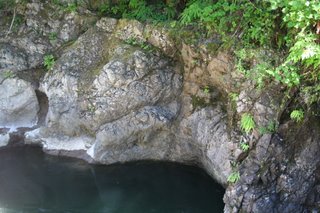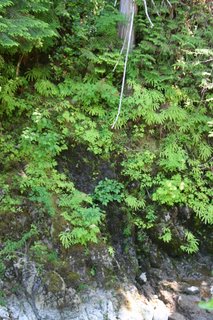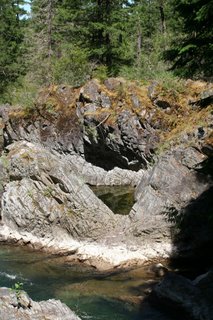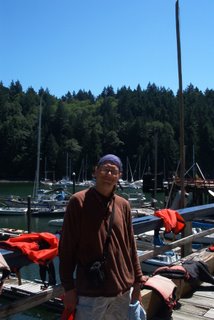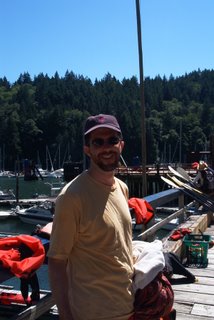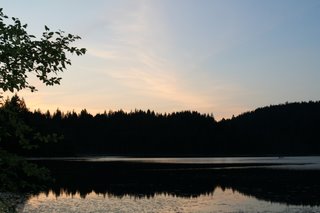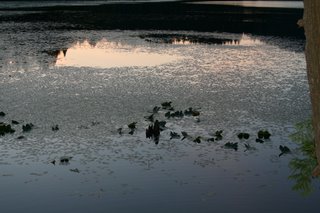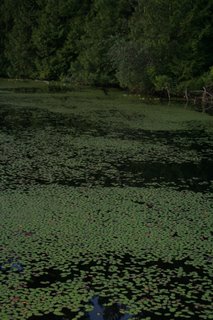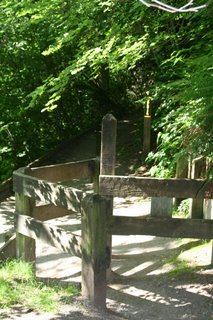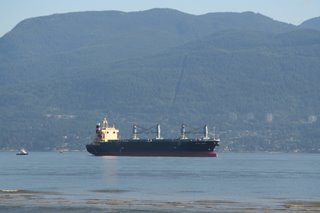Sunday, July 30, 2006
Little Qualicum Falls
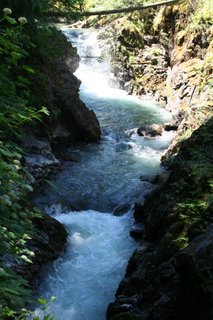 It is difficult to express, even through the medium of photographs, the grandeur and beauty of even so modest a watercourse as this one ("modest" in comparison to some other falls and gorges I saw in the course of my travels). The rocks here are very curiously formed, with what seem to be slashes across them as though they were raked first one way and then another by a giant cat's claws. The water is torquoise-coloured when viewed from one angle, but is quite clear, unlike most water in streams in Pennsylvania, which tends to carry a lot of organic sediment and clay, and so is "muddy" and brown or red. I was particularly impressed by the clarity of the water throughout almost all of British Columbia; even the Pacific at Wickanninish and Schooner Cove was astonishingly clear.
It is difficult to express, even through the medium of photographs, the grandeur and beauty of even so modest a watercourse as this one ("modest" in comparison to some other falls and gorges I saw in the course of my travels). The rocks here are very curiously formed, with what seem to be slashes across them as though they were raked first one way and then another by a giant cat's claws. The water is torquoise-coloured when viewed from one angle, but is quite clear, unlike most water in streams in Pennsylvania, which tends to carry a lot of organic sediment and clay, and so is "muddy" and brown or red. I was particularly impressed by the clarity of the water throughout almost all of British Columbia; even the Pacific at Wickanninish and Schooner Cove was astonishingly clear.
Automation at its best
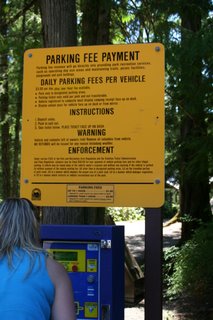
Here's an instance of automation I can't say I've ever seen in the States, but then, I don't get out much. You should be able to click on this image (and all the others on this blog) and call up a much larger version of the image; large enough, in this case, to read the instructions and warning.
Here the Canadian use of one-dollar coins ("Loonies" for the image of the loon minted on them) and two-dollar coins ("Toonies", which have polar bears) shows its worth in ease of automation. For an hour parking, you drop in a Loonie and receive a ticket, marked with the expiration time, which you place on the dash of the car. For longer than two hours, you put in three Loonies or a Loonie and a Toonie, receive a ticket and so on.
I suspect this is mostly an honour system (i.e. basically unenforced), but I didn't see a single vehicle without a ticket on the dash. And we did see some funky vehicles while on Vancouver Island!
25 vi 06: Horseshoe Bay to Tofino, Episode Two
10:43 Ferry from Horseshoe Bay to Nanaimo is at full steam. Estimated arrival at Departure Bay 12:25
11:23 BC Ferries Marine Life presentation
The arms of the Pacific Giant Octopus will get to be 32 feet long; the weight of these molluscs is the equivalent of a full-grown Grizzly Bear. The Pacific Giant is the most intelligent of octopi. Will eat fish -- or seagulls [apparently one was observed waiting in the the shallows near a beach and catching seagulls with its tentacles! Another story regarding the Pacific Giant involves an individual in an aquarium. The staff of the aquarium could not figure out why their fish were disappearing. Suspecting a human thief, surveillance cameras were set up, which eventually told the following story: every evening after the aquarium closed, the octopus, who knew that fish were to be had in the adjacent tanks, would squeeze into the water circulation pipes, move to the nearby tanks, eat fish, squeeze back into the circulation system, move on to the next tank, eat fish, and so on, returning to its own tank before the aquarium opened in the morning. (Of course, we know this is all just a matter of pure animal instinct, don't we? MEA)].
Keystone species: a species upon which an entire eco-system rests. A keystone species for the marine ecology of the Strait of Georgia is the Sea Otter. Sea Otters eat up to 30 sea urchins a day. If they did not do so, the sea urchins would devastate the Kelp, and cause a collapse of the entire system.
Regarding Orcas: Transient populations of orcas eat sea mammals, but the local orcas eat only fish. The locals are divided into clans: there are three clans in the southern part of the Strait and three in the north. The clans have distinct dialects of the orca language [the young woman giving the presentation played tape recordings of several different orca songs to illustrate] and distinct food preferences. The whales have a complex family structure. Females live to be 80 years, males live to 50. There is an interesting reason for this. PCBs (Polychlorinated Biphenyls, defined by Answers.com as "Any of a family of industrial compounds produced by chlorination of biphenyl, noted primarily as an environmental pollutant that accumulates in animal tissue with resultant pathogenic and teratogenic effects") build up in fatty tissue, but females flush them in their milk; males, of course, do not produce milk, and so more PCBs build up in their bodies, hastening their demise. (Of course, we know that this is the fault of the whales for living in water donated to humankind at the beginning of time, don't we? MEA) Orcas are technically porpoises rather than whales. There are three types of porpoises found in the Strait. Orcas are by far the largest at 30 feet in length.
Regarding Bald Eagles: Bald Eagles mate for life; the younger birds are all dark.
Regarding Bears: The Spirit or Kanogi Bear is a white phase Black Bear, not an albino. The numbers of this colour phase of the Black Bear are growing, as they are more successful at fishing, perhaps because of their colour.
12:32 leaving ferry in Nanaimo.
Sign outside Nanaimo: "Why do we have so many wise crackers and so few smart cookies?"
[We travel through the town of Coombs, famous for its tourist trap shops featuring grass-covered roofs on which goats cavort.]
Coombs founded by Thos. Coombs one of the majors in Salv[ation] Army to assist poor [Welsh immigrants] here.
1:58 p.m. in Qualicum Falls Provincial Park for lunch. [At this point in my travels, I was well supplied with apples and oranges by my nutritionist (and fruit enthusiast) cousin-in-law Ellie; I had also purchased some mildly spicy chiura (chidwa: a mixture of lentils, split peas, peanuts, noodles or rice, dry-roasted with spices and eaten as a snack) at the Ruddy Potato. I can't recall ever seeing chiura for sale outside of a specifically Indian grocery store before. I was still eating from that same bag of chiura in Alberta almost three weeks later!]
2:26 leaving Qualicum [welcome to the whirlwind world of the Moose Tour]
2:34 passing Cameron Lake, the deepest in Canada.
Cowichan: stop at Petro-Canada station for cold drinks many F[irst] N[ations] folks.
[My journal at this point does not do justice to the wonder I felt at walking into the petrol station. First of all, I was immediately impressed by the very large assortment of sweets: about four rows of shelves of nothing but (rather nasty) candies of the Sweet Tarts type, and many chocolate offerings like Butterfingers and Baby Ruth. They had Mentos and TicTacs, but no Altoids. I was on a quest for the latter, as I had the impression that my lunch of orange and chiura was not producing happy effects upon my breath. But I was rather willing to have halitosis than eat Mentos or TicTacs. The other shelves seemed to be stocked with survival gear, like jumper cables and punk sticks and fire-starting kits; somewhere between these two were the fatty snacks like Cheetos and puffed pork rinds.
The second, and more important, thing that impressed me, was that here we were, mostly very white Whites walking into a community composed, so far as I culd see, wholly of First Nations people, who were dressed in contemporary Western fashion: the young women, for example, had hip-hugger pants with wide studded belts, bellies exposed by midriff-cut shirts to show it all off; they were talking on cell-phones -- but they were not talking in English. Now, I'm used to people talking on cell-phones not in English. In Lancaster, we have a large Latino community, and I hear a lot of Spanish. But these folks were speaking a language I had never heard before, I'm guessing Hul'qumi'num'. I was quite impressed to find that young people were speaking the traditional language, and not just a small group of geriatric patients.]
3:17 Sproat Lake
[We stopped to take a look at petroglyphs carved in a rock face partly submerged in the Lake, which is also notable as the base for converted WWII bombers which are used now as fire-fighting planes. By the petroglyphs is a dock, and a number of young white folks were playing at the dock and jumping from the top of the cliff on which the petroglyphs are carved. As I was, of course, eagerly taking many photographs of the petroglyphs, the folks in the water suggested that I was there to photograph them as they leapt in. So I did, and showed them the result in the viewfinder, which they found most amusing.]
4 p.m. back from the petroglyphs. Many folks out at this lake -- and quite a few speaking non-English language.
4:07 off towards Tofino.
5:11 Ucluelet.
5:20 we reach Wickanninish, which means "no-one in front of him in the canoe." [We quickly went out to view the Pacific at the Pacific Rim interpretive center. I took some nice pictures and at the last minute dashed into the gift shop, where I was able to buy some very nice cards by a local, FN, artist, and beautiful but standard photo post cards.
[About 6 we arrive at the hostel, HI Whalers on the Point. I am in a room with two bunk beds, one occupied by two somewhat messy people, to judge by their gear: apparently francophone, and, I'm guessing by their guidebooks with French colophons, not Quebecoises but French. I learn later that they are French women from Lyon and Strasbourg.]
10 oclock pm 25 vi 06 It is about ten minutes past sundown and still quite light
11 oclock turn in
From my journal for 26 vi 06:
On dock last night with most of "the gang" from the Moose Tour after going to a "fish and chips" place which sold ridiculously large portions. Nearly everyone was either throwing food out or taking doggie bags.
Took prodigious numbers of photographs of the absolutely gorgeous sunset.
Retired early, but still must determine my account balance and other financial matters.
[Most of the crew from the Moose Tour went to eat at a local greasy spoon, where absolutely enormous portions of batter-fried fish and home fries were served up by a most amusing staff. The woman taking orders had a prize-winning smile which she maintained so consistently I began to wonder whether it might not be a sign of simplicity. Several of the Swedes asked for water, rather than soft drinks, to accompany their dinner, and were asked whether they wanted bottled water or tap water. They asked, quite sensibly, whether the tap water was safe to drink. "Yes," came the reply, "we have some of the best tap water on Vancouver Island. It's delicious!" I'm still not sure whether this was irony. At any rate, we all had the "delicious" tap water, and suffered no ill effects, although I must admit I didn't notice anything specially good about the water, although I did notice that it was not chlorinated.
[Very few of the people eating at the diner could finish their meals, and many were simply throwing away what amounted to entire sensible servings. The trash can was overflowing. One of the Swedes commented on this to the order-taker, who came around from the booth, and stood in the barrel to compress the contents! Then I assisted her in pulling the sack out of the barrel (her calisthenics rendered this rather difficult). She tied up the bag, put a new one in the barrel, and then went right back to serving up meals, without, so far as I could tell, washing her hands. Somehow this violated my sense of food purity.
[I had a veggie burger with mushrooms and cheese -- in an enormous bun; enough food for two meals by itself, plus a mountain of french fries. In the end, I asked for a box, and had what remained of the fries -- probably at least a pound -- for breakfast the next day.]
25 vi 06: Leaving Snug Cove
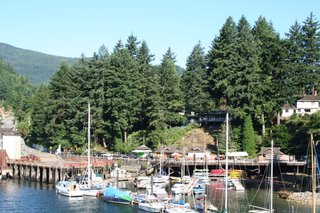
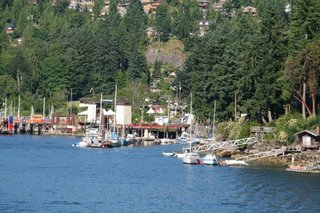
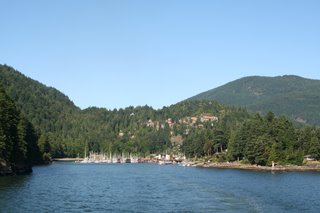
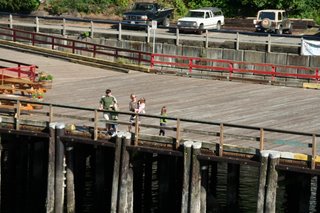
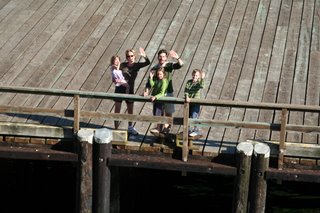
So, farewell to Snug Cove! The ferry slips out into the channel, leaving behind a community of some of the friendliest people I've ever met.
It's hard to know how to express the deep connection I felt at several points of my journey, but here virtually at the start I was treated with such care and consideration, I felt truly blessed to be in this world.
Thanks for the great food! Thanks for the comfortable bed! Thanks for the opportunity to wash my clothes! As Annie McInerney writes, "the simple pleasures in life are the best!"
Thursday, July 27, 2006
All Things Must Pass, 24 vi 06
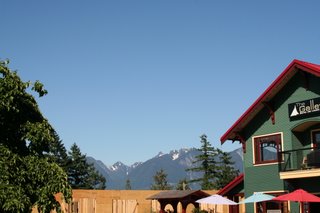
Read this photo and weep.
Essentially, this is the view from the patio by Cocoa West. Nice, isn't it? Check out the snow-capped mountains, the beautiful evergreen trees, even the building with its funky paintjob -- and the new construction. Do you think that building is going to have a flat roof, for the benefit of people sitting on the patio at Cocoa West? Or do you think maybe it will have a deck of its own, overlooking the Cove, and a sloping roof proportional to its size, which will almost completely obscure the view of the mountains? As Beorn said, "The day will come when they will perish and I shall go back!"
It's in the details
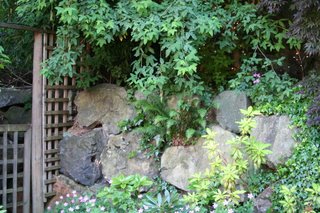
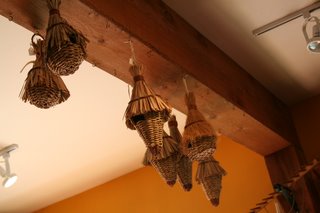
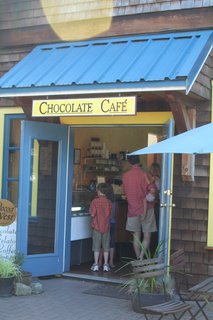
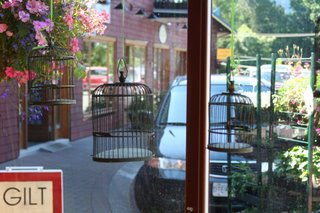
Some images from Artisan Square above Snug Cove on Bowen Island; the birdhouses and birdcages were in Silver Fern Florist Home / Garden, one of those garden shops from which I would like one (or two) of everything. Cocoa West chocolatiers and cafe served up an excellent cappuccino, complete with a water chaser. Their ice cream was also delicious. I sat on the patio and watched the twinkling fairy lights in the Japanese maple, seen in the top photo (can you see the fairy lights?)
So all you trekkers hiking up Mt Gardiner: when you've finished your climb, refresh yourselves at Artisan Square before you walk down the steps to the ferry. The views from the square are also spectacular.
Monday, July 24, 2006
Opa, Bowen Island, 24 vi 06
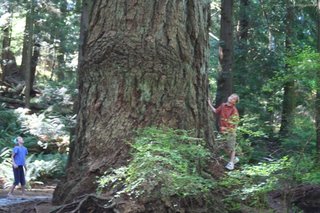
The two humans seen in this picture are less than a metre tall; an adult human standing by the child in the red shirt would come up to the wrinkly feature on the left of the trunk.
The tree in the center of the picture is Opa, a 500-year-old Douglas Fir. Opa's lowest branches, perhaps forty feet above the ground, are as large as the bases of any of the other trees in the immediate neighbourhood.
Local Fauna, Bowen 23 vi 06
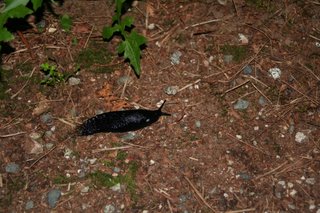
This little fellow was making her/his/its way along the path to Killarney Lake. While in BC I saw about two dozen slugs in shades of brown, black, yellow, and green; most were about the same size as this one: about five inches (10 cm). I was told on several occasions that this was small for slugs, but since I never saw any that were smaller, nor substantially larger, I guess that four or five inches is the standard size for slugs in the Pacific Northwest.
Horseshoe Bay to Tofino, Episode One
Left Bowen on the 8:30 ferry; the entire Mackay-Cole clan turned out to see me off. I was told that I simply must return at the end of my journey; the Mackay-Coles will have just returned from their trip south into California.
I looked back over the railing of the ferry as Snug Cove receded in the distance of the bright morning: the kayak rental shop, which during the business week pumps out reggae; the stores clustered against the hill above the marina; the heron flying low above the trees; cormorants on the rocks outside the cove...
My instructions from Moose Travel Network: "meet the "Pacific" Tour departing Vancouver on June 25th, confirmation #65790. Total fare is $869 CAD payable first day of travel. Please ensure you are at the Horseshoe Bay Ferry Terminal "Foot Passenger Pickup" are by 10 a.m. on June 25th. Your driver will pick you up from that location prior to your boarding the ferry. Do not buy a ferry ticket as your driver will do that for you."
Having crossed from Bowen Island to Horseshoe Bay, I exited the terminal and began looking for the "Foot Passenger Pick-up" area. None of the terminal staff appeared to be very clear on where that was. As 10 a.m. approached and I had seen no sign of a Moose Travel Bus (having, however, only a very poor notion of what such a bus would look like), I called the main office of Moose. This required me to do a bit of unpacking and repacking, but by this point I was used to that, having done it three times in the Vancouver Airport two days before!
Laura from Moose was typically willing to help, but unfortunately she also was unfamiliar with the exact location of the "Foot Passenger Pick-up" area. The difficulty, incidentally, is that there is no such area. Foot passengers typically enter the ferry separately from vehicle passengers. That a foot passenger might meet a vehicle, even a bus, at the ferry or on the ferry, is apparently so rare an occurrence that a protocol does not exist for it.
Something for BC Ferries to consider.
Laura did, however, describe the driver and tell me his name. So I was looking for Lee, who has really short hair. Not much to go by, true, but more than I had before. I closed my mobile, turned back toward the terminal, and noticed a man with somewhat short hair and what appeared to be a stack of tickets in his hand looking back and forth around the front of the terminal. I approached him, asked him whether he was Lee; he asked whether I was Mark, and of course then everything was fine. Lee commented that the terminal was too large not to be more specific in instructions as to where a passenger should wait.
Something for the Moose Travel Network to consider.
The Moose bus was parked in one of the lanes waiting to enter the Horseshoe Bay to Departure Bay ferry, but it was too hot to wait inside the bus, so I stood outside with the other Moosies, who had had an hour or so to make each others’ acquaintance already. I talked with some women with accents I couldn’t quite place. At this point in the tour I was wearing my Pennsylvania College of Art and Design ID badge, as a little shout out to Chris Welch, Chair of the Photography Department at the College. (No, sorry, Chris, no-one got a shot of me actually wearing the badge, I’m afraid, but I did at first. I also always carried some toilet paper in a ziplock bag, my toothbrush and toothpaste, and a Swiss Army knife [Victorinox]). Anyway, the badge proved to be a good icebreaker, and I ended up talking with some fellow academics, but the terminal was – and probably still is – a less than ideal place for a conversation. Very noisy and windy.
About half an hour after my arrival at the bus, we were ushered on board: three Japanese women, a Spanish man, two women from eastern Canada (one of whom spoke faultless Spanish), several English women, and two Swedish couples – the fellow academics, who had been at global sustainability conference in Vancouver. For some more information about their activities, see http://globalsustainability.org
We were informed that because of the rising costs of petrol, a surcharge would be added to our fare for the bus tour; this would be $2.00 for those taking the shorter tour of Vancouver Island, and $5.00 for those of us, such as myself, who would be taking a more extended tour.
Looking Backward, crossing to Bowen
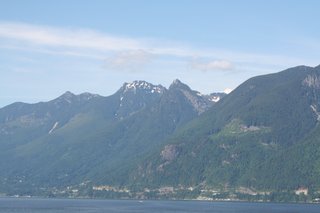
Here you can see some of the construction on the Sea To Sky Highway at the bottom of the picture; although Vancouver is the host city for the 2010 Winter Olympics, Whistler will be the location of many of the events, and to handle the anticipated volume of traffic between Vancouver and Whistler, the highway along that section will be widened and resurfaced. This requires a good bit of blasting and debris removal, as well as logging along the road. Throughout BC I observed strip logging and rock clearing on roadsides. More on that later.
Submerged Mountains in the Straits
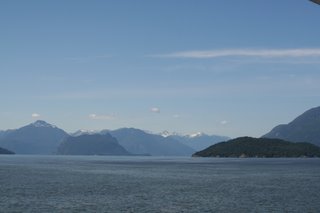 Stuart and I struggled to identify these mountains, but I believe now that at the far left, the small section in the midground is the far western tip of Gambier Island, the first peak on the left is Mt Wrottesley, the island in the center left partially hidden by haze is Anvil Island, the snowcapped peaks in the background are the Tantalus Range, the dark island in the center right is Bowyer Island, and the mountain behind Bowyer to the right is part of the mainland, but south of Tantalus.
Stuart and I struggled to identify these mountains, but I believe now that at the far left, the small section in the midground is the far western tip of Gambier Island, the first peak on the left is Mt Wrottesley, the island in the center left partially hidden by haze is Anvil Island, the snowcapped peaks in the background are the Tantalus Range, the dark island in the center right is Bowyer Island, and the mountain behind Bowyer to the right is part of the mainland, but south of Tantalus.Anyone with better information on the identifications is cordially invited to post a comment with corrections!
Towards Bowen, 23 vi 06
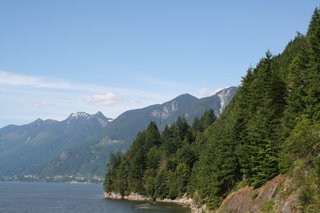
A view of the mountains north of Horseshoe Bay as Stuart and I take the ferry from Horseshoe Bay to Bowen Island.
Stuart told me that he values the ferry ride as a time for decompression from his job. When he comes across to the island, he is entering a safe place, apart from the world of work. Thus the theory, anyway.
I had a similar experience coming across the ferry later in my travels.
On Bowen Chez Mackay-Coles 24 vi 06
Morning, Ellie, who had gift certificates, treated me and Stuart to a sea-kayaking adventure. Never having been in a kayak before, this was a bit of a challenge: I wanted to use all my canoeing moves, which were not quite right. Also, I had trouble understanding the steering of the rudder. But we got out and back without terrible incident; I did cut my foot and thumb on barnacles or mussels, and the wound on my thumb particularly took about ten days to heal. Of course, neither of us thought to bring a first-aid kit. Braddock’s last words on that ["We shall know better how to deal with them next time"].
In the early afternoon, went with Ellie, Tara, Calum, and Molly to shops in Snug Cove: Phoenix Photo, which hardly sells any photographic equipment at all any more – it is now a card-shop, bookstore, toy store; the Ruddy Potato, a whole foods store to give Kimberton [Whole Foods, in Kimberton Pennsylvania] a run for its money; and a pet store, which was nice inasmuch as it was the local pet store and the Mackay-Cole kids love animals.
In the late afternoon, Stuart and the kids and I drove around the island to see Opa, a 500-year old Douglas Fir. On the way back we stopped in "Artisan Square", a quadrangle of shops and restaurants above Snug Cove, and accessible to the same by a set of steps. There I had a particularly fine cup of cappuccino, sitting in the sun on a beautiful patio surrounded by lovely architecture and gardens (including trees festooned with twinkling fairy lights), looking out over the snow-capped peaks of the Tantalus Range, also eating a pannecotta flavoured ice-cream from Cocoa West. Delightful.
Evening at Bowen Island Film Society meeting – behind the meeting house is a small fenced yard, beyond that a field in which two deer – one with antlers in velvet, one without antlers, are feeding; beyond that a fenced pasture in which three llamas are feeding, and up the lane to the left – clop, clop, clop, clp – two ponies with rides come, one a sorrel, the other a beautifully marked Appaloosa.
Voices in the Sound announcement: "a festival to celebrate who we are".
Fabulous movie "Touch the Sound" by Thomas Reidelsheimer about Evelyn Glennie, OBE, a world-class percussionist, who, incidentally, is also deaf.
Refreshments at this event included hand-made chocolate mousse from our very own Ellie Mackay-Cole, who graciously saved a cup for the present writer, who reciprocated by doing dishes and otherwise cleaning up after the event.
Stayed up late with Stuart observing the wonders of Google Earth. I am a little peeved that their house is perfectly clear on Google Earth, but our whole neighbourhood is just a blur.
Sunday, July 23, 2006
More Raw Journal: 23 vi 06
up at 6; checked out by 7:15 – no breakfast: café closed.
Made tea, talked with woman from Gloucester, England, then left and walked toward Spanish Banks. Low tide.
Vancouver sleeps in late.
Sand on beach I suspect may be artificial for humans’s pleasure.
9 a.m. I leave the beach proper for the walking path – thrushes heard from the shore called me.
Telephoto lens had proved its worth.
Wonderful shot of a sign "ROCKS" to warn swimmers at high tide
Hawkseye and wild oats strong smell of skunk:
Spotted? Striped? Roadkilled?
Spanish Bank Creek was restored in 2000 to provide spawning for Coho and Chub –
"Please help ensure the success of this project by keeping dogs and children out of the stream. Logs brush trees and shrubs have been placed to provide protection for young fish."
Walking "Admiralty" trail in Pacific Spirit Regional Park. Another walker with a dog commented "don’t often see a fully backpacked walker" – he recommended leaving Admiralty at the next stop (in environmentally sensitive area by creek) and walking on beach. But I have been on the beach and want to see more of the trail. Canadians are helpful and friendly as a whole and B-P [Lord Baden-Powell, founder of Boy Scouting and author of the seminal Scouting for Boys]would be proud of them.
Beautiful scene looking out of trees over beach towards mountains at "West Canyon" trail intersection with Admiralty. 10:17 a.m.
10:43 stalking the elusive thrush with the long 75-300. No success at images so far. Thrush eluded the macro lens and while I changed lenses it exposed itself along the path, flying off with a flourish as I removed the lens cap.
There is a pond near Jericho Beach east of the hostel, a favourite of birders, according to two walkers.
Pregnant woman and mate with two German Shorthaired Pointers, seven and ten years old, brown heads, spotted bodies, built like Weimaraners.
Bracken here as tall as I – arbutus trees shiny waxy evergreen foliage like rhododendron – no flowers, only fruit something like Oregon Grape.
11 attempted more shots of thrush
11:10 looking at [Greater Vancouver Transit Authority] map near Acacia Beach – female Ranger asked whether I needed help – # 44 bus will take me all the way into Burrard Street, but I must walk over the hill on the Salish trail to Chancellor Avenue.
[Shortly after meeting the ranger and taking her advice I found a laminated card with mobile phone numbers including several listed by first name, and then various wildlife agencies, regional police, and rescue squads. I reasoned that this belonged to the ranger, returned to Acacia Beach, but she had gone. I fit the card into an interpretive board at the Beach.]
To my right on Salish trail is a stream I can hear rushing over small falls but cannot see.
11:24 a.m. red-capped (?) Woodpecker in flight it shows white wing patches
Tsuga canadensis [Hemlock], young sapling, dead – not many older trees.
11:45 emerge from woods at a school
Met ranger again and told her where her card was.
12:15 waiting for bus 44 across from University Hill Elementary school:
while waiting for bus, drew sketch of mountains, treeline, school and playground equipment behind a chain link fence along divided highway.
12:35 p.m.
At the Chevron station bus stop, corner of 4th and MacDonald, waiting for the 2.22.N.22 Bus downtown – took bus 84 rather than 44; Driver the ubiquitous helpful sort, told me that the 44 runs only every ½ hour and I could transfer easily. So now I wait for this other bus. The 44 would have been a single run to Pender. In future I will follow that, although I appreciate the helpful spirit.
Something you don’t see in the States: a trash bin with an attached recycling rack. I sketched this in my notebook, but I also took a photograph of the specific bin from a different angle several weeks later. The top is sloped to deflect snow; the remainder of the bin is perforated metal; the rack is solid, but has a slit at the back for drainage. The legend on the rack reads "recycling rack bottles and cans only".
1.13 I am at the Seattle’s Best café in 550 Burrard [where I had agreed to meet my cousin Stuart, who works in 550 Burrard].
Took the 22 bus – really crowded. Excellent and amusing driver – one mildly unpleasant incident involving a man angry because the 22 did not stop one stop back – "I’m not upset – I’m curious – you just sort of stop whenever you feel like it." The driver’s reaction afterward: "people say all kinds of things to this uniform."
The Canadians make a lot of use of one and two dollar coins, sparing them, I suppose, some of the difficulties of printing vast quantities of ones. They surely wear better and probably automate better – the coins, not the Canadians – Why haven’t USAmericans caught on to this?
Reminiscent of Orwell’s comment on the British character [in "Why I Write"]: "the coins are heavier".
One could gain the impression that BC is unified culturally but what is most striking is the diversity of styles and backgrounds of persons I’ve met here – many orientals, yes, relatively few obviously First Nations – many Europeans, but again quite a range of these. Great diversity of accents and expressions.
The [Jericho Beach] hostel has its fair share of druggy drinking college kids but quite a few older folks with a range of experiences.
[The following description is not entirely from my raw notes; I had drawn several sketches and a thumbnail floorplan with explanatory notes rather than the narrative appearing below.]
Colour scheme in the Seattle’s Best: tomato bisque mocha wood light walnut or ash colour typical. Chairs of leather and wood, or just of wood, comfortable and squat. This particular SB is a kind of passageway between a "side entrance" to the building and the main building lobby. At the lobby side, bags of coffee and boxes of tea are displayed for sale in tall shelves; the bar and the coffee machines face out towar the lobby. A cart with milk and cups is placed between a bar seating area and the main seating area, where six large tables and seven smaller tables are arranged between great bay windows and a sort of half-wall; between that half-wall and the main food counter are five more larger tables, a counter, and then a space where folks can line up and see the food selections in glass cases. There is also a rack with soft drinks and bottled water. At the far end from the lobby is a gas fireplace with two large sofas and two enormous leather-covered arm chairs. Also at this end are the restrooms, which can only be accessed with a key from the staff.
The counter is like a wheel, repeated in a wooden design above the service area. A wall panel along the lobby wall declared "How we became Seattle’s Best Coffee" – a typical Horatio Alger story. The chairs here have an unusual lopsided design, hard to describe in words, and difficult enough to capture in a sketch. There is also a wooden suggestion box on the wall.
My cousin Stuart Cole, who works in 550 Burrard, said that I should look for a man with a beard and a yellow and black backpack – surprisingly few men have beards here. I don’t know that I was expecting to see many, but it is notable that there are so few.
1:58 p.m.
Awareness of time is the first step to the control of time.
It’s hard to make a schedule without a sense of sequence (=awareness of time).
Talked into a vanilla tea latte (=chai) by the barrista – not nearly as nasty as it might be.
$5.70; 6.05 = 11.75
The barrista says that he can make as much as a barrista in Vancouver as he could as a professional photographer in Winnipeg. He had a show at the Canadian Embassy in Bogota Colombia and thought this would propel his career....
East Indian fellow says he doesn’t want coffee to go: coffee must be enjoyed our of ceramic. Amen.
This led to the talk about photography: barrista said that he was in South America and could not get a coffee to go – this is partially the culture of hospitality.
What would it mean to create a culture of hospitality, where hospitality was the prime virtue?
Do mountains promote a culture of calm? The Nepalese – the Swiss – the Quiche – the "Ecotopian" all seem to be basically calm... laid back... accepting ... is this geographically influenced?
2:25 Arabic north African geometric tesselating Moroccan Moorish Navajo colour schemes influenced by landscape and culture.
Diffuse lighting colour a wall to cast that light into room use full spectrum lights but with a rheostat.
Disperse items - - use some bookshelf space for display.
Amazing to think only slightly over 24 hours ago I was arriving – very full catalogue of experience already. I shall have to sleep all July and August to recover.
Raise some baskets up on chest of drawers to create etagiere.
How to blend the natural findings and really existing landscape outside with the indoor decor – perhaps easier in a city where the outside environment is largely artificial.
2:36 Here are some African folks wearing robes and kente headdresses walking by – relatively few blacks here; I have the impression Europeans and Asians are about equal in forming the majority. Broad diversity of appearance, dress, and age coming into this building – not necessarily into the coffee shop, which is a kind of walkways between the main lobby of the building and a smaller side entrance, through which I came initially.
Ah, there goes a fellow with a beard ...
Many languages here, as well, partly an experience of the urbs also of a port city, but also a tribute to the invitation of Vancouver.
Here’s a fellow leaving the building with a backpack, a bag of golf clubs and a mohawk.
Bicyclists, one of whom seems to be a security guard – neither with bikes. Probably some type of courier – some bikes parked along street.
Guys with muscle shirts and tattoos "industrial" jeans -- and ID badges.
Stuart Cole recommends Café Artesiano for coffee; Hornsby Street
Photos 250-264 Horseshoe Bay to Snug Bay.
Evening with the Mackay-Coles; a protracted al fresca meal, lots of beer, coffee, and delectable chocolate cakes, a walk through the regional park which is literally across the street from the Mackay-Cole residence, and where a pair of owls had been reported. We saw no owls, but found two largish owl-pellets, much to the delight of the children. We walked as far as Killarney Lake, and then back. Then a late evening downloading some images and talking with Stu, then to bed in Calum’s room – Calum being quite happy to camp out in a sleeping bag on the carpetted floor of his parents’ bedroom.
Saturday, July 22, 2006
What a Great View
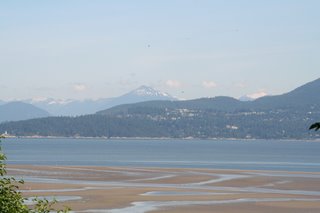 Here again, I am looking out from the trail in Pacific Spirit Regional Park across the inlet towards West Van. The tide is coming in, but is still low; in the middle ground at the left is one of the islands I will pass later on the 23rd June on my way to Bowen Island; Horseshoe Bay ferry terminal is on the other side of the low ridge in the middle ground. I'm still impressed by the sequence beach -- sea -- forested hills -- snow-capped mountains.
Here again, I am looking out from the trail in Pacific Spirit Regional Park across the inlet towards West Van. The tide is coming in, but is still low; in the middle ground at the left is one of the islands I will pass later on the 23rd June on my way to Bowen Island; Horseshoe Bay ferry terminal is on the other side of the low ridge in the middle ground. I'm still impressed by the sequence beach -- sea -- forested hills -- snow-capped mountains.
Protecting a Resource

This image shows part of a fence enclosing a "lagoon" or small pond on Spanish Banks Creek in Pacific Spirit Regional Park in Vancouver. The pond is spawning grounds for Coho and Chub salmon, two of the five varieties of Pacific salmon. While I think in Lancaster County it would be more common to enclose the area in chain link fence, perhaps also with barbed wire, the solution here, while not foolproof and probably not as durable, is stacked split rails -- this keeps dogs and children out, and is not particularly aesthetically offensive. Also, one can see down into the pond from a trail running uphill to the right of this photograph.
Tide with a twist
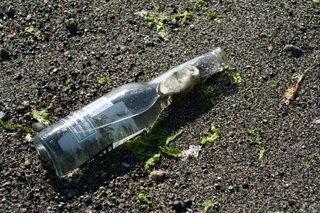
The Canadians do like their beer. That is to say, they like beer. Brits, Aussies, and Kiwis travelling in Canada seem also to have no objection to, and really a rather pronounced fondness for, beer.
I never personally observed anyone in Canada consume beer with the addition of lemon or lime, but the jetsam on Jericho Beach seems to provide some evidence for the practice.
I sampled a variety of local beers from Vancouver, Bowen Island, and several small towns in the Okanagan region. Being a fan of heavy, dark beers, though, I found little to compare with Troegs Rugged Trail. I drank a Guinness one night in Victoria and was upbraided by a Brit who was on the tour with me: "I can drink Guinness at home," he said. I pointed out that the Guinness I was drinking was in fact produced in Canada, but I also took his point and drank no more Guinness while in Canada. I did have quite a few pints of Alexander Keith's India Pale Ale while in Banff, but that was due to the insistence of Bennett "Just One Pint and then Back to the Hostel; Well, Just One More Pint and then Back to the Hostel" Ayling. I could have demurred, but it would have been unsociable.
Floats, Vancouver
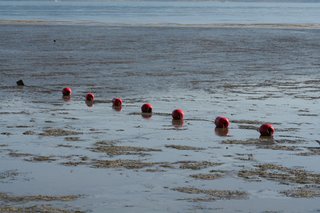
One of the features which particularly struck me about the Vancouver area was the way the human and non-human environments intersect. Often in human constructions the colours selected intellectually seem as though they should be wrong, but in practice they are harmonious and attractive. Here, the bright primary red of the floats against the browns and blues of the water, the pebbles, and the reflected sky makes a characteristic composition.
Images of Vancouver
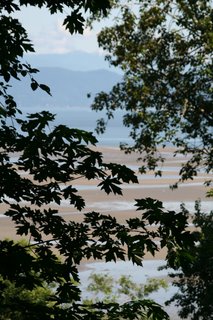
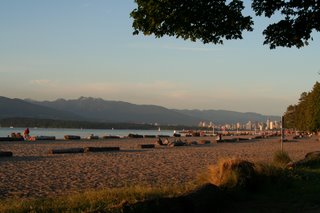
(Left) Vancouver from Jericho Beach. The downtown area of Vancouver is at the right hand side; the trees in the middle right conceal the Jericho Beach marina. The HI Jericho Beach is a five minute stroll to the right of that marina. The forested mass across the center of the image beyond the water is Stanley Park. It's hard to fathom from this picture that the photographer was standing within the metropolitan limits of a city of roughly two million inhabitants.
(Above) Looking out from the trail system in Pacific Spirit Regional Park, 23 vi 06 morning
Raw Material from the Journal
I had planned all along to keep a sketch journal and a journal of notes or reflections, and had purchased much larger and bulkier (and heavier) journals from an art-supply store, but in the final packing before my departure I jettisoned those in favor of the Moleskines alone. This was one of several technical changes or innovations I made surrounding this trip. I will recount the others in their turn.
To give a sense of the way I operate in preparing a journal, I submit for your edification raw, but obviously transcribed, notes from my journal.
22 June 2006
On way down [to Philadelphia airport from Lancaster] Suzy and I discussed our relationships with our cousins.
3:30 a.m. PHL terminal D Air Canada, United, Continental, Air Tran
Some Aussies from NSW with bicycle, golf clubs, etc. led off the march into United, which seems to be combined with Air Canada. Passed through security without incident (just the usual cluelessness – mostly afterwards – readjusting gear).
In place at gate D & listening to baroque concerto through the intercom at 5 a.m.
hardly seems like 90 minutes have elapsed heart racing a bit.
Met a nice young woman from Halifax NS who works for a Canadian salt company as a safety specialist – was at a safety conference in Phda and now returning to NS by way of Toronto.
Also some Indian-Americans (college age or so) who were late for their flight yesterday.
Grey two-tones – a feldgrau and a lighter silver grey with a Prussian blue in the much stained carpet in the United - Air Canada sector.
The baroque has given way to a kind of new-age impressionism – perhaps the largo movement but very loose.
Black leather and brushed steel double seats.
6:04 a.m. standing in a queue waiting for information card [required by USA Homeland Security] to be processed.
Jazz plane very small and cramped but I have the window seat for what that’s worth
7:00? Haze but sunny – rush of jets, not quite enough – then – airborne riding north and slightly east over the bend of the Delaware, then arching east –
now above a mixture of industry, farm, and suburbs – very many swimming pools glittering like blue opals from this height –
now a major six-lane highway and a smaller river (the Schuylkill?) Neat burbs, burbs, burbs as far as the eye can see –
now into a bank of clouds; wispy below, cumulus above
now those are past; now above a quarry
now into a turbulence and all is white – or grey – vapor streaks by the cadmium yellow upright at the end of the wind; we seem to be descending...
Patterns of a blanket of clouds
sometimes the clouds seem like ranges of mountains in plains
misty valleys
hard to think of the clouds as "insubstantial"!
Now leaving the comfortable plains of clouds and passing out over a dim steel-grey sea – and it is a sea – one of the great lakes – the waves and ripples on its surface catching the new sun light.
Now we are over a small bank of cloud again through which another small plane has just darted off to our right.
Now over water again.
The edge of the plain of clouds as we descend into Toronto.
8:44 a.m. Toronto.
Customs:
"What is your business in Canada?
You’re not going to visit any farms?
Why do you need all this photographic equipment?"
Had to be shuttled twice because of the size of the airport and apparently because of renovations. YYZ certainly seems much newer, brighter, perhaps cleaner than PHL. Also, the layout of suburbs seen from the air seems neater and less haphazard in Canada than in the States.
Had to take off shirts, belt, and boots as well as open my carry-on and photo-case as part of the customs inspections.
Now, waiting for boarding of my flight to Vancouver, 1187.
So far I have been too hot in teeshirt, linen shirt, and canvas outershirt, but I hesitate to place any of them in my backpack.
I’m also bilious and starting to feel a bit sleepy.
Sat next to Gina M, the salt safety woman from Nova Scotia, in the flight from Phda.
We will fly at 34,000 feet; it is 13 C in Vancouver now, it should reach 20 C today; it is partly cloudy there.
We will fly over Sault St Marie and Thunder Bay, then cross over into the Fraser Canyon.
While I wait I draw a sketch of the equipment on the ground out the window of flight 1187.
Cloud shapes above the land
the shadows clearly visible on the ground
patterns of wooded land along stream incorporated into rigid rectangular field plot scheme
quite a good deal of forested land to be seen here – the roads are all on the square
here and there are signs of old cuts – perhaps rail lines now defunct
now we see a town laid out in part "on the bias"
though why I can’t guess
Here a large bend of the road
banks of puffy clouds as we enter turbulence climbing to 30,000 feet
passing out over large body of water
the pattern of fluffy clouds over land and smooth over water
the captain came on minutes out to say that the turbulence noted above was unexpected
but experienced by all planes in the area – we will hold at 30,000 feet until we get to the Sault St Marie area, and then go higher to regular cruising altitude.
Behind the wing, lucid, luminous blue of the Great Lake – before the wing a shoreline which hardly seems to move, crowned with cloud
Perhaps I can find this shoreline? [On a map, based upon a sketch accompanying these words.]
Lakes
Now we pass over a substantial airport about two miles from the lake – we are now over land again.
This appears to be an island.
There is a lot of clear cutting timbering and mining here.
A large lake of reddish-brown sludge was hard to miss –
another smaller airport
the many small lakes "smeared" along the land and the reason for the heavy tannin-like stain into the lake at the river – acres and acres of clear cut land.
Clouds like webs
now the land is mostly hidden and it seems we are above water again
now we pass over thick ranges of clouds
Probably the last pages are of the island to the east of Sault St Marie
astonishing long fingers of land – like the edge of a rotting board
seem to jut out from the mainland or from some larger island
we seem to be over land again
a larger city is below us and to what I guess is the south –
again open mining mostly on the surface – in amongst lakes, forest, farms –
the roads are more irregular here. We are still ascending –
presumably we are just passing Sault St Marie
Looks like some hilly country here
roads here follow contours more
even the major highways
lots of lakes with this formula:
lake at center, beach and cleared ground, then forest.
Rivers passing through marshy ground, or so it would seem from here.
Many many lakes, sometimes joining as though to form larger bodies
the entire landscape now about half water and half forest – very few fields, not many roads – many small rivers with oxbows
occasionally on a lake what appears to be a boat or two
clouds
most logging leaves a brown mark, not a spotted green area...
In some places one can see the flow of the soil running off
the patterns of the lake seem to alternate between a kind of rounded amorphous and linear and "crumbly"
the clouds form "waves" which join in some places
now we see fewer lakes and more logging roads
like rocks in the Susquehanna at Lock 12 – but clouds
Now we pass over farmland with much larger plots than we have seen yet –
the cloud cover here is thick and deep
here and there below can see through the clouds – but in the distance if one looks carefully one sees great long roads converging beyond the horizon
these masses of cloud must be miles across – we approach them slowly enough that I can draw their individual features in outline before we pass
still the squared roads below
Now passing over a large brown lake, where the roads must scatter a bit
the water of the lake has turned a bright algae green broken by cloud shadows –
or perhaps it is blue water partially concealed by green stuff – at any rate a large body of water – now we see the shore...
Now algae bloom or other growth seems likely
a great range of cloud
now again the lake forests, dotted trees, fields, often with traces of "inferior" land
the cloud shadows are surprisingly dark on the land
we now travel over a plain of cloud like a field of snow into which great snowballs have been thrown here and there forming craters with a smooth lump in the middle. These are great thunder head like clouds in the main mass.
We move at such a rate that the clouds ahead seem not to move at all – it is as though we are suspended motionless
the roads often seem to break off at the edges of parcels -- to prevent one sleeping at the wheel?
Here, the cloud plain seems to clear a little, and the ground looks like a decaying plate of iron – many eskers and drumlins [what I meant here was small glacial lakes -- persons with decent geological training may laugh now]; the brown ground dotted with them but farming amazingly seems to go on around them
the human grid over the dotting of lakes is odd
there is a great river in the distance which seems to have been dammed or filled
at several points
At places the many tiny lakes converge into a greater mass – not exactly a lake, but a less-ground-than-water place
the river now opens out into a wide place – I should guess roughly the size of Lake Aldred.
Here the first evidence I’ve seen of contour farming – also what appear to be canals or ditches as in northern Indiana. Just as in some places the lakes converge, in others the ground seems to pull itself together and forms a "drier" section. It’s here that we see the canals.
Here’s what’s left of a river channel, smeared and obliterated by what forces I could not say.
The houses here must be roofed in steel – they shine like silver dots on the land, no more than points, but recognizable as houses.
Here again – is it a lake or a river, or just a lot of water sluggishly flowing?
There’s a spot there the little lakes are mostly dried up dust bowls, and the larger lakes have a yellow creamy foam colour
Here the unvaryingly straight road crosses a khaki-hued lake
thunderheads form beneath us
now silken-smooth clouds from horizon to horizon hiding all the earth from view
when anything can be seen, it’s more of the same...
AND NOW –
river through deeply carven banks
many of the large lakes seem to be silted brown, or are two tones of khaki, very distinctly marked
about an hour from Vancouver, we pass over a large city, mostly hidden by cloud (this proves later to be Calgary)
now – what appear to be snowfields – sluggish rivers – roads once again scattered over the land.
The Rockies!
Did he say 60 degrees or 16 degrees in Vancouver?
We begin to descend over Kelowna (kah-low-nah)
mountain peak like a knife, next to a long trough
All the mountainous region is marked by cumulous clouds, presumably the air heated by the sun on the stone rises up to form these
large lake and
many clear cut patches
we seem to be descending towards the Coastal Range
The clouds now look like nothing more than a white, rose, and blue forest – the ground below is forested, though heavily logged as well.
Now we see hills rather than mountains – hills like the Blue Ridge – still snow on the taller hillsides
Now the hills give way to mountains again and the peaks of the mountains rise up above the clouds!
Now we pass over a large city on the edge of a Lake – Kelowna
the wakes of motorboats can be seen on smaller lakes to the west – the great mountains still approach
rosy in the distance it seems to stand still
yet each moment it is nearer and more distance. We descend
behind us the hills and the crinkled clouds
coming in to what I presume to be the Fraser Valley all clouds behind
this mountain to the south and the great mountain beyond it [I learn later this is Mt Baker in Washington State]
glimpses of a river – a great lake – like river just beneath us, snow-flecked moutains, ever-green forests, a great dam
another river in the distance – houses – farmlands – a great city on the banks of the river, greenhouses, golfcourse, malls – the Straits of Georgia – the Pacific!
Logging rafts on the river railroad sidings and now the city spreading to the sea.
424, 10 to airport station C90 to 98 B-line transfer to #98 to Granville and 5th Avenue, cross Granville Street using the underpass take bus #4 to NW Marine Drive walk downhill, first right to Jericho Park.
Arrival in Vancouver airport almost anticlimactic to the flight – no customs – no fuss, just right out to the baggage claim, which, notably, was very easy to find. My cell-phone, as it happens, has "miraculously" changed to local time. Could not quite figure out how to get the bus to work, or rather, how to work the bus properly. I dug though my pack a second time to find the directions to Jericho Beach. I went to an ATM and took out $100 CAD then to the Post to buy a 16x stamps @ 51c CAD ea then to a 7-11 to buy a bottled water and a map of the Vancouver transit authority – then back out to the bus area. Fortunately, saw a fellow with a backpack and several other packages – thought we could at least be clueless together – he turned out to be quite familiar with the bus system; from NZ, he hadn’t been living in NZ for ten years, but had just been home to NZ and returned at that moment to his home of for years in Vancouver. He had also hiked for two weeks in China. "With a tour or just on your own?" I asked him. "Just on my own." "Do you speak any of the Chinese languages?" "No- but I went anyway. I picked up a few phrases. It's amazing how much you can communicate without words." I think the USA may breed xenophobes, but NZ seems not to.
Having received instructions and assistance from the Kiwi, I left him with my card at 4th Street, made my transfer, and arrived at Jericho Beach around noon local time. I called Suzy and Willow, walked down to the beach and back, went to my room, tried ineffectually to correct some problems with my cellphone, and fell asleep until 7 p.m. local – thinking that this was 4 p.m. local [because I hadn't grasped that my cellphone had adjusted]...
Washed, came to the hostel café – many Germans here
Dinner at Hostel Café: $6.25 CAD for tea, a burger, and salad. That, four granola bars, and a hummus pita ($5.00 USD) on plane, two cups weak tea also in plane, water, and bagel - isotonix OPC-3, and mochatonix before departure from Lancaster were my total intake today.
[Went for a walk in the evening to Pacific Spirit Regional Park:]
Many familiar species in the Pacific Spirit Regional Park (I came as far as the "Pioneer" trail along the "Spanish" Trail beginning at Spanish Banks) – many thrushes – beautiful! Quite a few maples of a species I don’t know. Heuchera, Beggar’s Ticks, Plantain, various raspberries, Oregon Grape a common forb, great ferns; a sort of red elderberry is quite common.
The sun has just set; it’s 9:24 p.m. local time; the mosquitos are terrible and it’s getting cold fast for a guy in tee shirt and linen long-sleeve, even with my ear cap!
What I took originally as a geranium or fern is shown by its flower to be a sort of Bleeding Heart with a pink inflorescence. Trailing Arbutus (? but prob.). Back to hostel by 10 – ½ hour walk from Spanish Banks west [actually east] to Discovery Avenue.
Up til 1 with the hostellers – and cleaned up after them.
Choosing Moose
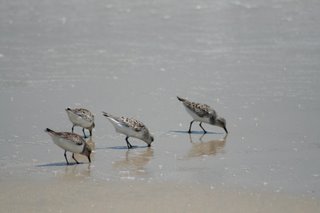
As I began to narrow my view of what I could realistically see in Canada, I decided that what was of greatest interest personally was the Pacific northwest. It seemed to me that here was a situation with a wide range of ecosystems within what appeared to be a relatively small compass (relatively...!). I planned an itinerary around what little information I had (I was, after all, in the midst of the academic year and a department-wide self study; I was not at liberty, I felt, to spend much time pre-researching).
My parents offered the opinion that I was not psychologically suited to travel on my own through unfamiliar territory. They urged me to join some sort of package tour. I was equally adamant that I wanted flexibility in the tour, and that I did not want to go to the sorts of sites recommended -- perfectly appropriately within context -- by the AAA/CAA guides.
Somehow my mother, an inveterate researcher, discovered several "adventure tour" packages, and after examining their websites with some care I concluded that the one which most closely matched my existing itinerary was run by the Moose Travel Network out of the Vancouver area.
I think I came to my conclusion to join the Moose sometime in March of 2006, just as my final report on the Departmental study came due. I'll admit I didn't examine every detail of the Moose program, nor did I then think relevant some of the points I now see as fundamental to one's happiness while travelling with the Moose. I'll address those points later.
I was planning originally to leave on my journey in the second week of May, but several events conspired against that. First, it was necessary to re-fence the pasture to prevent further truancy on the part of our donkeys, with whom the local constabulary were becoming rather to intimate, which is to say the cops were coming to our house telling us that the donkeys had jumped the fence all too frequently. The fencing project took several weeks. Second, my cousin living in Bowen Island informed me that May weather may be "dicey" in British Columbia. Third, it seemed easier on my wife to manage the household if I waited to go until after the public school year was over in the first week of June. So the departure was set back by three or four weeks.
By April I had secured airline reservations, and room reservations in Vancouver, Victoria, Shuswap, Revelstoke, and Kelowna. Then in May my school year ended, final grades were turned in, and I felt I could really concentrate on preparing for the journey. I had about two weeks to put finishing touches on my plans, and during that time my wife and daughter and I went to Rehoboth Delaware for four days. We all got a bit more sun than we should have; my wife and I were especially badly burned. I was still peeling weeks later in Whistler, BC, much to my chagrin.
The image above is of shorebirds at Assateague National Seashore in Maryland, taken as part of an exercise in juggling photographic equipment and other hiking gear. I must have looked at least somewhat professional with two camera bags, a camera around my neck, and a full daypack, since at least three people approached me and asked whether I worked for the National Geographic Society! I really tried to tone things down by the time I arrived in Vancouver.
